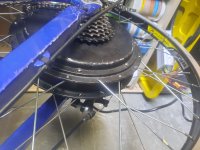I don't have anywhere near your experience in wheelbuilding, and I trust an experienced eye, which is why I asked for the details of your thoughts on this failure.

I don't doubt I could build (significantly) better wheels, more spokes probably would help, but it's not just one wheel that worked on this trike. It's several, all of which experienced much more severe conditions and much heavier loads, for longer, than this one, and none of which failed (discounting a single spoke failure at one time or another).
I've done plenty of heavy cargo hauling (up to and including a piano on a DIY trailer with four different typical 26" bicycle wheels in side-by-side pairs, though the trip was pretty short, only a couple of miles) with various sized wheels on various bikes, trikes, and trailers, both before I came here and started electrimotorificating things, and after, almost all of them just common 36-spoke bicycle wheels, most of which I didn't build or rebuild, some of which were pretty crappy, and none of them failed like this--the worst failure I can recall (not counting one destroyed from motor torque via chain derailment) was when I used a solid-tube rear wheel on DayGlo Avenger, and it literally just beat the wheel to death fairly rapidly..even then it just loosened the spokes and deformed the rim, didn't break them like this.
That's what leads me down the path of this specific wheel being problematic in some way that led to the failure, some way that is different from the wheels I built, that I hope can be analyzed and determined with some reasonable certainty.
I'd like to figure that out so I can ensure I never do whatever was done in building this wheel by whoever built it.

Also because I usually have a "burning need" to know why any one specific thing failed in whatever particular way it did. (I probably missed a good career in failure analysis. :lol: )
Anyway, I disassembled the broken wheel and took pictures as I went. I'll write it up and post it in the other thread and link it here once I get that done later tonight.


